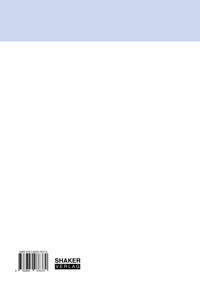
Shop : Weiterempfehlung
Shop
Weiterempfehlung
45,80 €ISBN 978-3-8440-7637-0Paperback146 Seiten48 Abbildungen215 g24 x 17 cmEnglischDissertation
Oktober 2020
Christian Hartl-Nesic
Surface-Based Path Following Control on Freeform 3D Objects
Today, process automation solutions strongly rely on programmable and multi-functional robotic manipulators to perform repetitive and for the human operator partly tedious processing tasks for large-scale series productions. Many of these processes require the movement of a robot-mounted tool along a given geometric path defined in the Cartesian space. From a control engineering perspective, this task is called path following control and emerges in processes such as milling and cutting.
The work at hand is concerned with the development of a novel surface-based path following control concept for the processing of 3D objects. In contrast to classical path following control, the presented control concept systematically takes into account the surface normal vector of an underlying freeform 3D surface and the path tangent vector of the surface-based path. Using a coordinate transformation and feedback linearization, the nonlinear robotic system dynamics is transformed into a system with linear input/output behavior in new path-based coordinates. Moreover, industrial processes on freeform 3D surfaces are described in terms of kinematic constraints, i.e. forbidden tool motions, and kinematic redundancies, i.e. free self-motions of the tool.
The control concept is validated experimentally with a KUKA LBR iiwa 14 R820 by a novel approach for the versatile application of (curved) pre-cut adhesive tapes on freeform 3D surfaces. The experimental design of the demonstrator results from a thorough concept study.
Surface-based path following control is a general and modular framework to describe and perform various industrial processes on freeform 3D surfaces with diverse kinematic and dynamic requirements, e.g., polishing, laser cutting, sewing, and spray painting.
The work at hand is concerned with the development of a novel surface-based path following control concept for the processing of 3D objects. In contrast to classical path following control, the presented control concept systematically takes into account the surface normal vector of an underlying freeform 3D surface and the path tangent vector of the surface-based path. Using a coordinate transformation and feedback linearization, the nonlinear robotic system dynamics is transformed into a system with linear input/output behavior in new path-based coordinates. Moreover, industrial processes on freeform 3D surfaces are described in terms of kinematic constraints, i.e. forbidden tool motions, and kinematic redundancies, i.e. free self-motions of the tool.
The control concept is validated experimentally with a KUKA LBR iiwa 14 R820 by a novel approach for the versatile application of (curved) pre-cut adhesive tapes on freeform 3D surfaces. The experimental design of the demonstrator results from a thorough concept study.
Surface-based path following control is a general and modular framework to describe and perform various industrial processes on freeform 3D surfaces with diverse kinematic and dynamic requirements, e.g., polishing, laser cutting, sewing, and spray painting.
Schlagwörter: Robotik; Pfadfolgeregelung; Industrielle Prozesse; Freiformoberfläche; Drapierprozess
Modellierung und Regelung komplexer dynamischer Systeme
Herausgegeben von Univ.-Prof. Dr. Andreas Kugi (TU Wien), o. Univ.-Prof. Dr. Kurt Schlacher (JKU Linz) und Prof. Dr.-Ing. Wolfgang Kemmetmüller (TU Wien), Wien / Linz
Band 49
Die Weiterempfehlung wird per E-Mail an die von Ihnen unten angegebene Adresse verschickt.
Die mit einem * gekennzeichneten Felder sind Pflichtfelder! Bitte füllen Sie diese unbedingt vollständig aus.
Shaker Verlag GmbHAm Langen Graben 15a52353 Düren
Mo. - Do. 8:00 Uhr bis 16:00 UhrFr. 8:00 Uhr bis 15:00 Uhr
Kontaktieren Sie uns. Wir helfen Ihnen gerne weiter.



